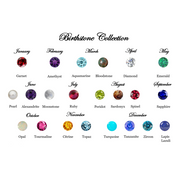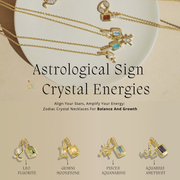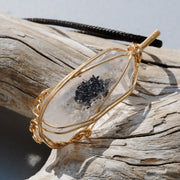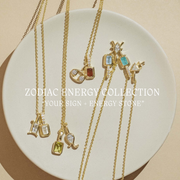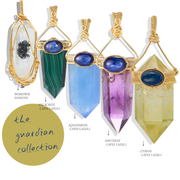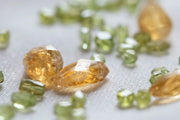Lapis Lazuli History
Ancient Origins
Lapis Lazuli has captivated humanity for over 6,000 years, admired for its deep celestial blue and golden flecks that resemble the night sky. The gemstone’s name originates from the Latin lapis meaning “stone” and the Persian lazaward, meaning “blue.” First mined in the ancient region of Badakhshan, Afghanistan, Lapis Lazuli was one of the earliest gemstones to be traded and worn by royalty, priests, and artisans. Archaeologists have found Lapis jewelry, beads, and carvings in Mesopotamian, Egyptian, and Indus Valley civilizations, proving its enduring importance in human history.

Cultural and Spiritual Significance
In ancient Egypt, Lapis Lazuli was treasured as a symbol of the heavens and immortality. Pharaohs adorned their tombs with Lapis amulets to guide them in the afterlife, and Cleopatra famously used ground Lapis to create her signature blue eye makeup. In ancient Mesopotamia, it was considered a sacred stone of truth and divine favor, while in medieval Europe, artists crushed it into ultramarine pigment—the most expensive blue used in Renaissance paintings. Across cultures, Lapis Lazuli represented wisdom, honor, and the pursuit of enlightenment.

Symbolic Uses Through Time
Throughout history, Lapis Lazuli has been seen as a bridge between the earthly and the divine. Ancient healers believed it could ward off evil spirits and strengthen the soul’s connection to truth. In Buddhism, it symbolizes inner peace and mental clarity, while in modern metaphysical traditions, it is associated with intuition, self-awareness, and emotional balance.

Table of contents

Origin
Afghanistan – The legendary Sar-e-Sang mines in Badakhshan have produced the world's finest Lapis Lazuli for millennia, prized for its intense royal blue hue and golden pyrite specks.
Chile – Known for lighter shades with white calcite streaks, Chilean Lapis offers a softer, sky-blue appearance popular in decorative carvings and jewelry.
Russia (Siberia) – Produces high-quality Lapis with deep color saturation and minimal calcite, often used in luxury ornaments and fine jewelry.
Feature
Chemical Formula: (Na,Ca)₈(AlSiO₄)₆(SO₄,S,Cl)₁–₂ — a complex mixture primarily composed of lazurite, with calcite and pyrite inclusions.
Mohs Hardness: Ranging between 5 and 5.5, Lapis Lazuli requires gentle handling and should be protected from scratches or strong chemicals.
Color: Typically deep royal blue with shimmering golden pyrite flecks and occasional white calcite veins. The intensity of the blue depends on the sulfur content within lazurite, with purer compositions producing richer hues.
Symbolism: Lapis Lazuli symbolizes truth, wisdom, and enlightenment. Spiritually, it enhances self-awareness, inner vision, and harmony, guiding the wearer toward honesty and spiritual growth.
-
Chakra:
Throat Chakra (Vishuddha): Encourages clear communication and self-expression.
Third Eye Chakra (Ajna): Stimulates intuition, insight, and mental clarity.
-
Zodiac:
Sagittarius
Libra
Benefits
Mental Clarity and Truth
Lapis Lazuli is often called the “Stone of Wisdom and Truth.” It clears mental fog and encourages honest communication, helping individuals express themselves authentically. This clarity of thought strengthens decision-making and enhances intellectual ability, making it ideal for students, leaders, and creatives.
Emotional Healing
Emotionally, Lapis Lazuli brings deep calm and emotional stability. It helps release repressed feelings, heals trauma, and balances mood swings. Its soothing energy nurtures compassion and self-acceptance, making it a comforting ally during periods of stress or personal transformation.
Spiritual Awakening
Known for its connection to the Third Eye Chakra, Lapis Lazuli heightens spiritual awareness and intuition. It promotes deep meditation and insight, connecting the mind to higher realms of consciousness. Many spiritual practitioners use it to enhance psychic abilities, lucid dreaming, and awareness of the soul's purpose.
Protection and Harmony
In ancient times, Lapis Lazuli was worn as an amulet to protect against psychic attacks and negative energy. Even today, it is considered a shield against emotional manipulation and spiritual imbalance. Its energy harmonizes relationships by fostering honesty, empathy, and mutual respect.
Physical Healing
Healers associate Lapis Lazuli with the throat, respiratory, and nervous systems. It’s believed to relieve insomnia, boost the immune system, and reduce inflammation. Its calming vibration can also ease headaches and tension, especially those caused by stress or eye strain.
Type
Afghan Lapis Lazuli
Mined from the historic Sar-e-Sang mines, Afghan Lapis is the highest grade, showcasing deep cobalt-blue hues with minimal white calcite and abundant golden pyrite. Its unmatched intensity and glow make it the benchmark for quality worldwide.
Chilean Lapis Lazuli
Characterized by lighter sky-blue tones with visible white calcite patterns, Chilean Lapis has a softer, more pastel aesthetic. It’s often used in sculptures, pendants, and decorative art pieces due to its gentle beauty and affordability.
Siberian Lapis Lazuli
Russian or Siberian Lapis features a balanced mix of blue and golden inclusions, producing a refined, elegant look. Highly durable and vibrant, it’s favored for intricate jewelry and luxury artifacts.
Care & Maintenance
Cleaning
Clean Lapis Lazuli gently using lukewarm water and a soft, damp cloth. Avoid soaps, detergents, or ultrasonic cleaners, as chemicals can dull its polish and alter its surface.
Storage
Store Lapis Lazuli jewelry separately in a soft pouch or lined box to prevent scratching. Keep it away from direct sunlight or heat sources, which can fade its vibrant blue over time.
Handling
Avoid contact with perfumes, lotions, and household cleaners, as Lapis is porous and can absorb liquids. Always remove your jewelry before bathing, swimming, or exercising to preserve its luster and integrity.
FAQs
Q: Is Lapis Lazuli a birthstone?
A: While not an official modern birthstone, Lapis Lazuli is often associated with December and symbolizes wisdom, truth, and insight.
Q: How can you tell if Lapis Lazuli is real?
A: Genuine Lapis shows a rich, matte-blue color with natural golden pyrite specks. Fake versions often look overly shiny or have uniform blue coloring without variation.
Q: Is Lapis Lazuli rare?
A: High-quality Lapis, especially from Afghanistan, is increasingly rare due to limited mining and high demand in global markets.
Q: Can Lapis Lazuli go in water?
A: No, prolonged exposure to water can damage its polish and cause the stone to weaken or discolor.
Q: What does Lapis Lazuli symbolize spiritually?
A: Lapis Lazuli represents truth, enlightenment, and spiritual growth. It opens the mind to self-awareness and fosters honest communication.
Final Thoughts
Lapis Lazuli: Benefits, Properties and Meaning of the Stone reveal why this ancient gemstone continues to fascinate and inspire. From the royal tombs of Egypt to modern spiritual practices, its deep celestial blue has symbolized truth, enlightenment, and inner harmony. Whether worn as jewelry, used in meditation, or displayed as art, Lapis Lazuli connects the wearer to higher consciousness and the eternal pursuit of wisdom. More than just a gemstone, it is a timeless companion for the soul—illuminating the path to clarity, self-discovery, and peace.

